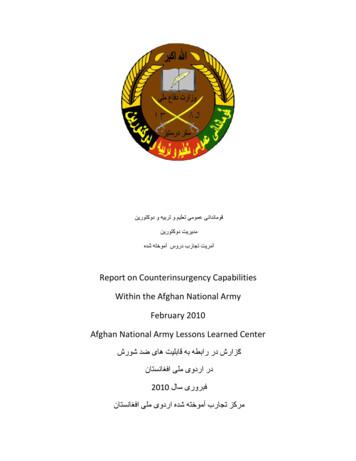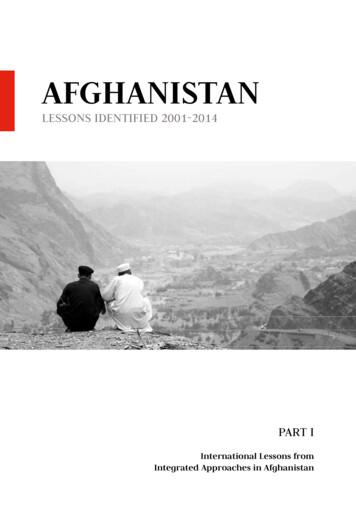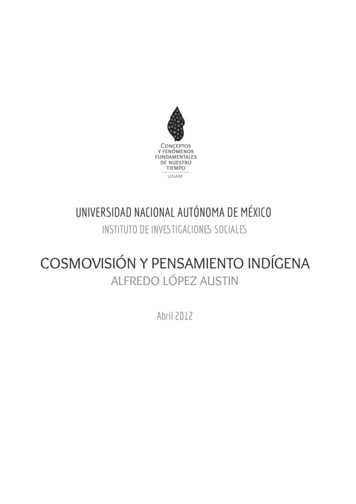FAQs On Afghan Priority 1 And Priority 2 Referrals U.S. Refugee .
FAQs on Afghan Priority 1 and Priority 2 ReferralsU.S. Refugee Admissions Program1. What is a “Principal Applicant”?The Principal Applicant (PA) is the individual affiliated with the U.S. government or otherwiseeligible to be referred to the U.S. Refugee Admissions Program (USRAP).2. Who constitutes an eligible family member?The Principal Applicant’s spouse and children of any age, whether married or unmarried, areeligible to be referred to the USRAP based on the Principal Applicant's affiliation with the U.S.government.3. I would like to refer an Afghan to the USRAP. Should I refer them to the P1 or P2program?If the individual meets any of the following three criteria, refer them to the P2 program: Afghans who do not meet the minimum time-in-service for a Special Immigrant Visa (SIV)but who work/worked on a full-time basis as contractors, Locally Engaged Staff (LES), orinterpreters/translators for the U.S. Government, USFOR-A, ISAF, or Resolute Support; Afghans who work/worked for a U.S. government-funded program or project inAfghanistan supported through a U.S. government grant or cooperative agreement; Afghans who are/were employed in Afghanistan by a U.S.-based media organization ornongovernmental organization. Note: For this category, Afghan employees may bereferred by an American senior employee of these organizations.If the individual does not meet any criteria above, but is known to Embassy Kabul, he or she maybe eligible for referral to the P1 program. Work with your agency’s representative at EmbassyKabul to determine if the individual is eligible for referral to the P1 program.4. If a potential Principal Applicant might be eligible for a SIV, but was never able to get aletter of employment verification to start the SIV process, can they be referred to the P1 orP2 program?Yes. If the Principal Applicant qualifies for both the P1 and P2, refer them to the P2. If the PrincipalApplicant does not qualify for P2, but is known to the Embassy, refer them to the P1. If thePrincipal Applicant does not qualify for either the P1 or P2, they cannot be referred to the USRAP.5. Can an individual pursue refugee processing under this program if they have an activeSIV application?The Bureau of Population, Refugees, and Migration (PRM) will not reject a referral for the P1 orP2 program just because an applicant has an active SIV application. However, given limited StateDepartment Consular Affairs and PRM resources, it is most efficient if referring agencies focusAILA Doc. No. 21081935. (Posted 9/22/21)
on submitting P1 or P2 referrals for Afghans who do not qualify or have access to the SIV program.This will maximize U.S. government resources for Afghans at-risk.6. Can I refer an Afghan resident who does not have Afghan nationality to the USRAP underthe P2 access category if he or she worked for a U.S. government entity and permanentlyreside in Afghan?No. The Principal Applicant’s nationality must be Afghan.7. Which route is faster, SIV processing or refugee resettlement? How long will the refugeeresettlement process take?We are unable to predict whether it would be faster to process in the SIV program or for refugeeresettlement, as that depends on the particularities of each individual case. Refugee resettlementprocessing may take 18-24 months from the time the applicant is in an eligible processing location,and sometimes longer.8. I’m interested in referring an Afghan national who worked for a sub-contractor of aDepartment of Defense prime contractor. Can sub-contractors be referred to the P1 or P2? This individual cannot be referred to the P2 program because U.S. sub-contractors, subgrantees, etc., do not qualify for the P2 program. However, if this person is known toEmbassy Kabul, and in imminent danger, he or she may be eligible for P1 referral.9. Should the Principal Applicant and family request asylum when they get to the country ofasylum in order to attain international protection?This will depend on the country of first asylum. In countries where UNHCR is present and thereis no functioning asylum system, the Principal Applicant and family should register with UNHCRfor international protection reasons. If the Principal Applicant and family are in a country with afunctioning asylum system and they do not have a legal status in the country (i.e., valid visa orsimilar), the family may consider applying for asylum if they believe they have compellingprotection concerns and may be danger of being forcibly returned to Afghanistan.10. How will the Department of State verify if the Principal Applicant and family are in acountry of asylum so that case processing can begin?The Principal Applicant will be given instructions to contact PRM via email once they haverelocated to a country of asylum. Once the Principal Applicant contacts PRM with thisinformation, PRM will assign the case to a Resettlement Support Center (RSC) to begin caseprocessing. Note: If the family decides to relocate elsewhere, they will need to notify the RSC thatthey were originally assigned to and that RSC will determine whether the case needs to betransferred elsewhere.11. What does the process look like once case processing starts? Does the Principal Applicantand family have to go into an office or would most of the processing be virtual?AILA Doc. No. 21081935. (Posted 9/22/21)
Prescreening interviews are generally conducted in-person, at the RSC’s office. However, all RSCshave the ability to conduct prescreening interview remotely depending on the RSC's COVIDprotocol at the time. DHS/USCIS interviews are generally conducted in-person but may take placevia video in exceptional circumstances.12. Could the family and/or Principal Applicant travel back and forth from Afghanistan?USCIS will ask questions about travel back to Afghanistan during the USCIS interview and willuse this information in their assessment of the refugee claim. It is not prohibited for the applicantto travel back, but it could have an impact on their refugee claim based on the assessment of theUSCIS officer.13. Can a referring agency or individual provide DHS/USCIS additional information orevidence at the time of adjudication? For example, if the Principal Applicant had traveled tothe asylum country with his/her family, then returned to Afghanistan to work, could areferring agency provide additional details about how those actions were in the U.S.government’s interest and should not invalidate the PA’s refugee claim?DHS/USCIS will be represented on the USRAP Interagency Task Force (IATF) where this will bediscussed and DHS/USCIS officers will be briefed on country conditions and caseload profile inadvance of interviews.14. If the Principal Applicant’s family relocates to the country of asylum ahead of thePrincipal Applicant, could case processing begin for the relocated family members? Couldthe Principial Applicant be interviewed virtually while still in Afghanistan?The Principal Applicant needs to be in the country of asylum with the rest of the family in orderfor refugee processing to take place. A prescreening interview cannot be scheduled with RSC staffuntil the Principal Applicant is in the country of asylum as the Principal Applicant cannot beinterviewed remotely from Afghanistan. The family does have the option to begin processing ontheir own, separate refugee case, without the Principal Applicant, but must be able to articulatetheir own refugee claim as part of the application process. If the family chooses this option, thePrincipal Applicant would be processed separately on his or her own case and would not beprocessed with their family until/unless they reunite with the family in the country of asylum. Inpractice, this means the Principal Applicant’s family could complete the refugee process anddepart to the United States without the Principal Applicant. In this circumstance, there is noguarantee the Principal Applicant would be reunited with his or her family.15. What if the Principal Applicant and family went to the asylum country, did the initialprescreening, and then the Principal Applicant returned to Afghanistan?This would not be advisable, as it could impact the DHS/USCIS adjudication. The PrincipalApplicant must be present and available for the DHS/USCIS interview in order for the case toproceed to conclusion. The family members cannot complete the process and will not be able totravel to the U.S. without the Principal Applicant as the Principal Applicant is part of the case.AILA Doc. No. 21081935. (Posted 9/22/21)
16. I want to refer someone who doesn’t know they are being referred. When/how will thisperson be notified that he or she was referred and can move forward with case processing?The referrer will be notified once the referral has been accepted. It is the referrer/their agency’sresponsibility to keep in touch with the Principal Applicant and notify the applicant that they havebeen referred to the USRAP when it is appropriate to share such information. At that time, theagency can provide the applicant with PRM’s specialized email address and stress to the applicantthat PRM will only be able to respond to the applicant’s email if the applicant is writing to confirmthat he or she has reached a country of first asylum.17. I am responsible for submitting my agency referrals into PRM’s case managementsystem. I do not have the information necessary to fill out a required field. Do I have to redothe entire referral?The required fields when submitting an Afghan Referral Record consist of the minimuminformation necessary for PRM to ensure eligibility for the USRAP and to allow for caseprocessing to begin. If any required fields are missing at the time of submission, the system willdisplay an error message and the record will not be submitted. The referrer can ‘Save’ the referralat any point and return to fill in the missing information.18. I am responsible for submitting my agency referrals into PRM’s case managementsystem. I submitted the referral record but have not received notification from PRM if thereferral was accepted. What is the status of the referral?When an Afghan Referral Record is created a Referral ID number (ARR-XXXXXXXX) isassigned to the record along with a default Status of ‘New.’ Referral records can be viewed by theuser who created the record. Agency representatives with access to PRM’s case managementsystem can search the Referral ID number at any time to see the current status of the referral,defined as follows:StatusNewPending ReviewAcceptedDefinitionThe Afghan Referral Record has been created by a referring agency but hasnot yet been submitted to PRM for review.The Afghan Referral Record has been submitted by a referring agency to PRMfor review. The referral will remain at this status until PRM reviews thesubmission and makes a determination on eligibility.The Afghan Referral Record has been accepted by PRM, and PRM has sent anotification to the Principal Applicant, with the referrer and form submitter incopy, to contact PRM at a specific email address once they have reached acountry of asylum. (Note: If the applicant was not aware they had beenreferred to the USRAP, PRM will only email the agency referrer and formsubmitter. The agency will have to inform the applicant, when appropriate, ofthe accepted referral.) The referral will remain at this status until the PrincipalApplicant contacts PRM via email to confirm they are in another country, atwhich point PRM will transition their referral record into a case which isAILA Doc. No. 21081935. (Posted 9/22/21)
Rejectedassigned to the nearest Resettlement Support Center (RSC) overseas to begincase processing.The Afghan Referral Record has been rejected by PRM as the applicant wasdetermined to be ineligible for the P1 or P2 Afghan program.19. I/my agency submitted a referral into PRM’s case management system, and I received anotification the referral was accepted. Can you explain the next steps of the process?If PRM determines the referral is complete, and the Principal Applicant knew they were referredto the USRAP, PRM will accept the referral and send a message to the Principal Applicant, copyingthe referrer and form submitter, instructing the Principal Applicant to contact PRM at a specificemail address once they have reached a Country of First Asylum.If PRM determines the referral is complete, and the Principal Applicant does not know they werereferred to the USRAP, PRM will accept the referral and send a message to the referrer and formsubmitter informing them of the acceptance. The agency must advise the Principal Applicant theyhave been referred to the USRAP when appropriate to do so and instruct the Principal Applicantto contact PRM at a certain mailbox once they have reached another country.A successful refugee application will complete the following steps prior to arrival to the UnitedStates: Step 1: Acceptance to the Program. Once the individual informs PRM via email that theyare in another country, PRM will assign their case to its nearest Resettlement SupportCenter (RSC) overseas to begin case processing.Step 2: Prescreening Interview. A Resettlement Support Center (RSC) conducts an indepth interview with refugee applicants in order to prepare their case files. The interviewcollects biographical information, reasons for flight and information regarding pastpersecution.Step 3: USCIS Interview. USCIS officers review the case file compiled by RSC andconduct an interview with each refugee applicant to determine eligibility for admission tothe United States. The ultimate determination as to whether an applicant can be admittedas a refugee is made solely by USCIS.Step 4: Security Checks. Before an individual is admitted to the United States forresettlement, the U.S. government must conduct several security checks. Security checksare completed throughout the entire duration of the process and must be cleared before acase can depart for the United States.Step 5: Medical Examination. Medical examinations are required for all applicants priorto entry to the United States. RSCs coordinate medical examinations with IOM and U.S.Embassy panel physicians.Step 6: Resettlement Agency Placement. Cases are assigned to a Resettlement Agencyin the United States that is responsible for receiving refugees and providing certain benefitsupon arrival.Step 7: Cultural Orientation. Prior to departure, approved refugees over the age of 14 areeligible to participate in cultural orientation classes provided by the RSC. The purposeAILA Doc. No. 21081935. (Posted 9/22/21)
of cultural orientation is to prepare refugees for resettlement by providing them with abasic introduction to life and culture in the United States. Step 8: Travel. The International Organization for Migration (IOM) will organize theapplicants’ travel to the United States.20. Do people approved for refugee status in the P1 or P2 programs have Legal PermanentResident (LPR) status upon arrival in the U.S.?No, refugees are required to apply for LPR status one year after arrival. Refugees do receive workauthorization documents shortly after arrival.21. I have more questions. How do I contact PRM with my questions?Due to the high volume of questions, you must route your question through your USRAPInteragency Taskforce representative. Your representative is knowledgeable about the intricaciesof this program and will be able to address most questions. However, if your representative doesnot know the answer, he/she will raise questions with PRM during a regularly scheduled USRAPTaskforce meeting to ensure you receive a response promptly.***If you are a USAID Partner, your questions should be routed toUSAIDAfghansupportcell@usaid.gov and will be answered as quickly as possible ***AILA Doc. No. 21081935. (Posted 9/22/21)
This will maximize U.S. government resources for Afghans at-risk. 6. Can I refer an Afghan resident who does not have Afghan nationality to the USRAP under the P2 access category if he or she worked for a U.S. government entity and permanently reside in Afghan? No. The Principal Applicant's nationality must be Afghan. 7.
107 Afghan – Popcorn Pattern 108 Afghan – Raised Flower 109 Afghan – Reversible Pattern 110 Afghan – Ripple or Ric Rac 111 Afghan – Original Design 112 Afghan – Any other pattern 113 Afghan – XL, larger than 56”x72” 114 Apron, all crochet 115 Ba
For the hottest afghan in crochet, check out the Snuggle Afghan, the afghan with arms (pg. 38). Find quick and easy patterns for any level, including the Earth-tones Knit Afghan (pg. 10) and the Crochet Zigzag Throw (pg. 18). For more free crochet and knitting patterns and to purchase the materials listed in these patterns, visit Red Heart Yarn.
Graphic Afghan:Sarah Fama’s afghan is worked in bulky wool with a geometric knit and purl chevron pattern. This reversible blanket knits up quick and will grace your sofa for years to come. Mosaic Tile Afghan:Judith L. Swartz’s afghan is a beautiful gathering of individual squares sewn together to suggest a
Afghan National Army's Counterinsurgency Director's assessment of counterinsurgency capabilities across the Afghan National Army. In order to assess counterinsurgency operations in the Afghan National Army, a Collections and Analysis Team from the Afghan Lessons Learned Center visited ANATC Training Centers and the Corps to gather .
an organisational form of inter-agency cooperation that could guide the national efforts in Afghanistan. Moreover, it seems that the various forms that did eventually emerge did . ANA Afghan National Army ANDS Afghan National Development Strategy ANP Afghan National Police ANSF Afghan National Security Forces ARTF Afghan Reconstruction Trust Fund
ACOG Advanced Combat Optical Gunsight ALP Afghan Local Police ANA Afghan National Army ANCOP Afghan National Civil Order Police ANP Afghan National Police A-POB Anti-Personnel Obstacle Breaching System ASF American Special Forces CAO Civil Aff airs Offi cer COC Combat Op
The FY 2022 ASFF request consists of four Budget Activity Groups (BAG) to include: BAG 6 -Afghan National Army; BAG 7 Afghan National Police; BAG 8 - - Afghan Air Force;and BAG 9 - Afghan Special Security Forces. The table in each section compares requested funding amounts in these BAGs to the FY 2021 and 20 20 appropriated amounts.
Por Alfredo López Austin * I. Necesidad conceptual Soy historiador; mi objeto de estudio es el pensamiento de las sociedades de tradición mesoamericana, con énfasis en las antiguas, anteriores al dominio colonial europeo. Como historiador no encuentro que mi trabajo se diferencie del propio del antropólogo; más bien, ignoro si existe alguna conveniencia en establecer un límite entre .























